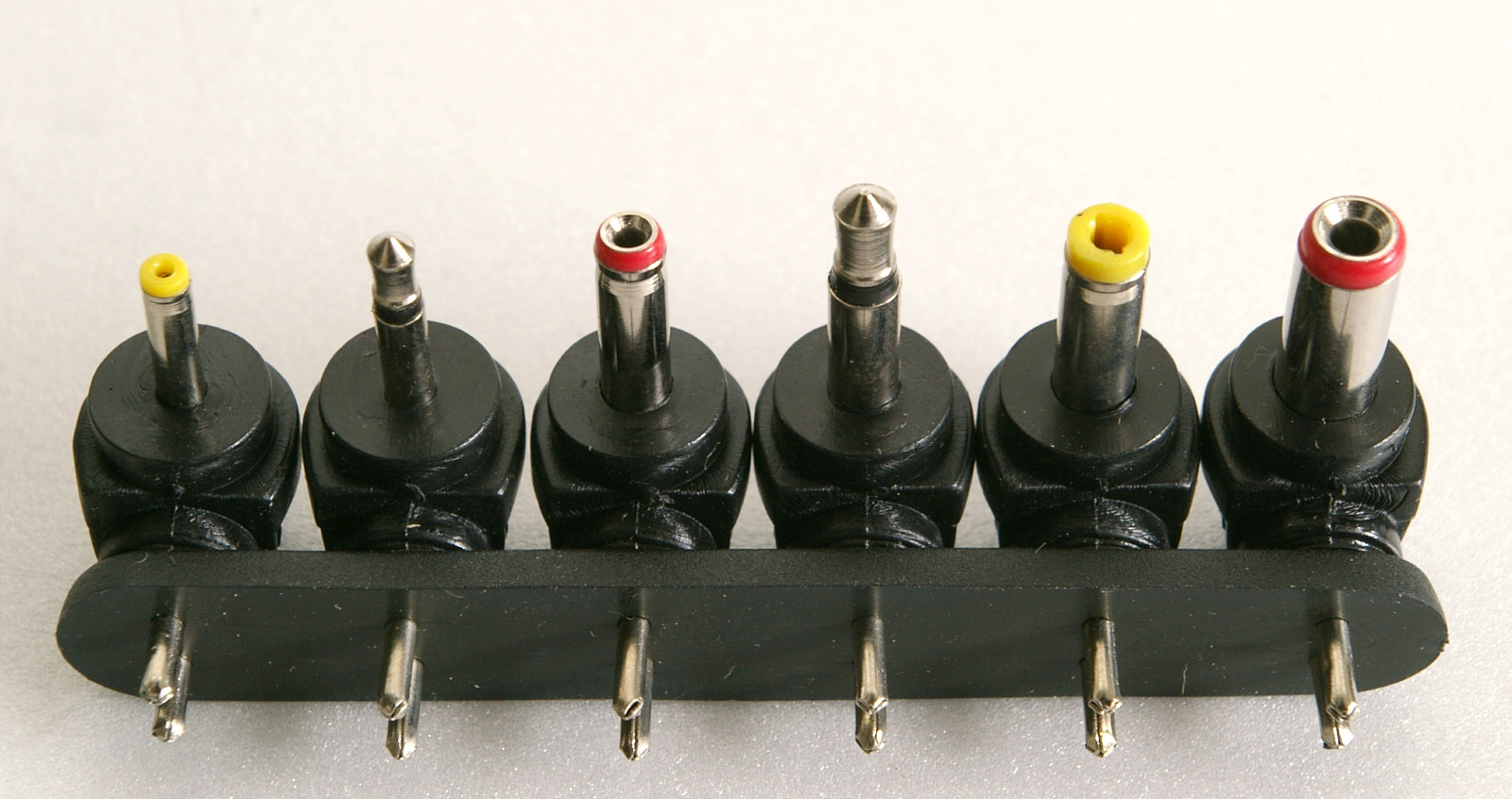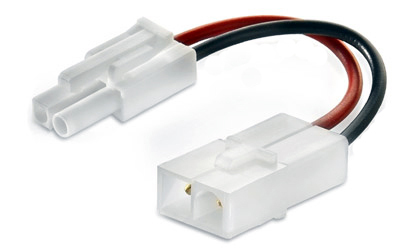|
DC Power Connector
A DC connector (or DC plug, for one common type) is an electrical connector that supplies direct current (DC) power. Compared to domestic AC power plugs and sockets, DC connectors have many more standard types that are not interchangeable. The dimensions and arrangement of DC connectors can be chosen to prevent accidental interconnection of incompatible sources and loads. Types vary from small coaxial connectors used to power portable electronic devices from AC adapters to connectors used for automotive accessories and for battery packs in portable equipment. Extra-low voltage (under 120 VDC) These extra-low voltage connectors are rated at or below 120 VDC. Cylindrical connectors Small cylindrical connectors come in various sizes. They may be known as "coaxial power connectors," "barrel connectors," "concentric barrel connectors," or "tip connectors." These plugs are intended for use on the cable connected to an external AC adapter (power supply). The matching jack ... [...More Info...] [...Related Items...] OR: [Wikipedia] [Google] [Baidu] |
S-Video
S-Video (also known as separate video, Y/C, and erroneously Super-Video) is an analog video signal format that carries standard-definition video, typically at 525 lines or 625 lines. It encodes video luma and chrominance on two separate channels, achieving higher image quality than composite video which encodes all video information on one channel. It also eliminates several types of visual defects such as dot crawl which commonly occur with composite video. Although it is improved over composite video, S-Video has lower color resolution than component video, which is encoded over three channels. The Atari 800 was the first to introduce separate Chroma/Luma output in late 1979. However, S-Video was not widely adopted until JVC's introduction of the S-VHS (Super-VHS) format in 1987, which is why it is sometimes incorrectly referred to as ''Super-Video''. The S-video format was widely adopted in consumer equipment due to its improvements over composite video. However, it was ... [...More Info...] [...Related Items...] OR: [Wikipedia] [Google] [Baidu] |
Radio Control
Radio control (often abbreviated to RC) is the use of control signals transmitted by radio to remotely operate a device. Examples of simple radio control systems are garage door openers and keyless entry systems for vehicles, in which a small handheld radio transmitter unlocks or opens doors. Radio control is also used for control of model vehicles from a hand-held radio transmitter. Industrial organization, Industrial, Military organization, military, and scientific research organizations make use of radio-controlled vehicles as well. A rapidly growing application is control of unmanned aerial vehicles (UAVs or drones) for both civilian and military uses, although these have more sophisticated control systems than traditional applications. History The idea of controlling unmanned vehicles (for the most part in an attempt to improve the accuracy of Torpedo, torpedoes for military purposes) predates the invention of radio. The latter half of the 1800s saw development of many suc ... [...More Info...] [...Related Items...] OR: [Wikipedia] [Google] [Baidu] |
Tamiya Connector
A Tamiya connector is a type of DC connector, DC power connector, commonly used on radio-controlled model vehicle battery packs, Unmanned aerial vehicle, drones and Battery charger, chargers. They are also commonly used on airsoft guns. The connector was designed by Japanese manufacturer Tamiya Corporation. The connector is still available from connector manufacturers such as Molex. The following connectors are compatible with the Tamiya connectors: 19-09-1029 with crimp 02-09-1119 and 19-09-2029 with crimp 02-09-2116. Wiring The usual wiring has the Electrical polarity, positive (red) wire running to the terminal with a square profile, and the Electrical polarity, negative (black) wire running to the half-circle, half-square terminal. This is true for both genders of connector. The female sockets are in a male housing and the male pins are in a female housing. The male pins (female housing) connector is usually on the battery side. In electrical and electronics engineering, the ... [...More Info...] [...Related Items...] OR: [Wikipedia] [Google] [Baidu] |
IEC 61076 (LV)
The International Electrotechnical Commission (IEC; ) is an international standards organization that prepares and publishes international standards for all electrical, electronic and related technologies. IEC standards cover a vast range of technologies from power generation, transmission and distribution to home appliances and office equipment, semiconductors, fibre optics, batteries, solar energy, nanotechnology, and marine energy, as well as many others. The IEC also manages four global conformity assessment systems that certify whether equipment, system or components conform to its international standards. All electrotechnologies are covered by IEC Standards, including energy production and distribution, electronics, magnetics and electromagnetics, electroacoustics, multimedia, telecommunications and medical technology, as well as associated general disciplines such as terminology and symbols, electromagnetic compatibility, measurement and performance, dependability, desi ... [...More Info...] [...Related Items...] OR: [Wikipedia] [Google] [Baidu] |
ISO Metric Screw Thread
The ISO metric screw thread is the most commonly used type of general-purpose screw thread worldwide. They were one of the first international standards agreed when the International Organization for Standardization (ISO) was set up in 1947. The "M" designation for metric screws indicates the nominal outer diameter of the screw thread, in millimetres. This is also referred to as the "major" diameter in the information below. It indicates the diameter of smooth-walled hole that an externally threaded component (e.g. on a bolt) will pass through easily to connect to an internally threaded component (e.g. a nut) on the other side. For example, an M6 screw has a nominal outer diameter of 6 millimetres and will therefore be a well-located, co-axial fit in a hole drilled to 6 mm diameter. Basic profile The design principles of ISO general-purpose metric screw threads ("M" series threads) are defined in international standard ISO 68-1. Each thread is characterized by it ... [...More Info...] [...Related Items...] OR: [Wikipedia] [Google] [Baidu] |
IEC 60320
IEC 60320, entitled "Appliance couplers for household and similar general purposes", is a set of standards published by the International Electrotechnical Commission (IEC) that defines non-locking appliance couplers for connecting power supply cords to electrical appliances. These couplers are intended for use with devices operating at voltages up to 250 Volt, V (Alternating current, AC) and currents up to 16 Ampere, A. The standard specifies various types of connectors, differentiated by shape and size, to accommodate different combinations of current ratings, temperature tolerances, and Earthing system, earthing requirements. Unlike IEC 60309 connectors, IEC 60320 couplers are not keyed or color-coded to indicate voltage; it is the responsibility of the user to ensure that the appliance's voltage rating is compatible with the local mains supply. The standard uses the term ''coupler'' to refer collectively to both the appliance inlets and outlets, as well as the connectors on po ... [...More Info...] [...Related Items...] OR: [Wikipedia] [Google] [Baidu] |
IEC 60309
IEC 60309 (formerly IEC 309 and IECEE, CEE 17, also published by European Committee for Electrotechnical Standardization, CENELEC as EN 60309) is a series of international standards from the International Electrotechnical Commission (IEC) for "plugs, socket-outlets and couplers for industrial purposes". They are also referred to as "pin & sleeve" connectors in North America or as "CeeForm" connectors in the entertainment industry. The maximum voltage allowed by the standard is direct current, DC or alternating current, AC; the maximum Current (electricity), current, ; and the maximum frequency, . The ambient temperature range is to . There is a range of plugs and sockets of different sizes with differing numbers of pins, depending on the current supplied and number of phases accommodated. Connectors generally are specified by the voltage and current ratings, general configuration (number of pins), and rotational alignment ("keying"). The fittings are popular in open-a ... [...More Info...] [...Related Items...] OR: [Wikipedia] [Google] [Baidu] |
Direct Current
Direct current (DC) is one-directional electric current, flow of electric charge. An electrochemical cell is a prime example of DC power. Direct current may flow through a conductor (material), conductor such as a wire, but can also flow through semiconductors, electrical insulation, insulators, or even through a vacuum as in electron beam, electron or ion beams. The electric current flows in a constant direction, distinguishing it from alternating current (AC). A archaism, term formerly used for this type of current was galvanic current. The abbreviations ''AC'' and ''DC'' are often used to mean simply ''alternating'' and ''direct'', as when they modify ''Electric current, current'' or ''voltage''. Direct current may be converted from an alternating current supply by use of a rectifier, which contains Electronics, electronic elements (usually) or electromechanical elements (historically) that allow current to flow only in one direction. Direct current may be converted into alt ... [...More Info...] [...Related Items...] OR: [Wikipedia] [Google] [Baidu] |
Alternating Current
Alternating current (AC) is an electric current that periodically reverses direction and changes its magnitude continuously with time, in contrast to direct current (DC), which flows only in one direction. Alternating current is the form in which electric power is delivered to businesses and residences, and it is the form of electrical energy that consumers typically use when they plug kitchen appliances, televisions, Fan (machine), fans and electric lamps into a wall socket. The abbreviations ''AC'' and ''DC'' are often used to mean simply ''alternating'' and ''direct'', respectively, as when they modify ''Electric current, current'' or ''voltage''. The usual waveform of alternating current in most electric power circuits is a sine wave, whose positive half-period corresponds with positive direction of the current and vice versa (the full period is called a ''wave cycle, cycle''). "Alternating current" most commonly refers to power distribution, but a wide range of other appl ... [...More Info...] [...Related Items...] OR: [Wikipedia] [Google] [Baidu] |
Extra-low Voltage
Extra-low voltage (ELV) is an electricity supply voltage and is a part of the low-voltage bandIEC 61140:2016 Chapter 4.2 in a range which carries a low risk of dangerous electrical shock. There are various standards that define extra-low voltage. The International Electrotechnical Commission (IEC) and the UK IET (BS 7671:2008) define an ELV device or circuit as one in which the electrical potential between two electrical conductor, conductors or between an electrical conductor and ground (electrical), Earth (ground) does not exceed 120volts (V) for ripple-free direct current (DC) or 50V (root mean square volts) for alternating current (AC). The IEC and IET go on to define actual types of extra-low voltage systems, for example separated extra-low voltage (SELV), protected extra-low voltage (PELV), functional extra-low voltage (FELV). These can be supplied using sources including motor / fossil fuel generator sets, transformers, switched PSU's or rechargeable battery. SELV, PELV, FE ... [...More Info...] [...Related Items...] OR: [Wikipedia] [Google] [Baidu] |
International Electrotechnical Commission
The International Electrotechnical Commission (IEC; ) is an international standards organization that prepares and publishes international standards for all electrical, electronics, electronic and related technologies. IEC standards cover a vast range of technologies from power generation, transmission and distribution to home appliances and office equipment, semiconductors, fibre optics, batteries, solar energy, nanotechnology, and marine energy, as well as many others. The IEC also manages four global conformity assessment systems that certify whether equipment, system or components conform to its international standards. All electrotechnologies are covered by IEC Standards, including energy production and distribution, electronics, magnetics and electromagnetics, electroacoustics, multimedia, telecommunications and medical technology, as well as associated general disciplines such as terminology and symbols, electromagnetic compatibility, measurement and performance, dependa ... [...More Info...] [...Related Items...] OR: [Wikipedia] [Google] [Baidu] |








